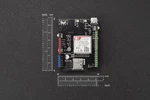








SIM7070G Arduino NB-IoT / LTE / GNSS / GPRS / GPS Expansion Shield (Global)
- $37.90 3+ items
- $35.90 5+ items
- $33.90 10+ items
Introduction
The NB-IoT expansion board, designed specifically for Arduino controllers, is globally frequency-compatible, supporting CAT-M, NB-IoT, GSM, GPRS, EDGE communication methods, and GNSS satellite positioning functions.
Its ultra-low power consumption and precise positioning characteristics, coupled with support for CAT-M and GNSS satellite positioning, make it an ideal choice for smart logistics, asset tracking, smart cities, and other fields.
This expansion board is not only suitable for prototype development but also for small batch production, making it an optimal choice for low-power, low-latency, and medium-throughput applications. It has built-in GNSS satellite positioning, including GPS, GLONASS, Galileo, and BD, making it highly suited for IoT applications such as remote control and mobile tracking.
The SIM7070G also comes with a rich set of built-in AT commands and provides detailed libraries, user manuals, and application documents, including usage methods for network communication protocols such as HTTP, MQTT, FTP, CoAP, NIDD, PING, etc., enabling quick start without deep understanding of underlying network protocols.
Most importantly, the SIM7070G has passed relevant certifications in multiple countries and regions worldwide, including CCC, CE, AT&T, FCC, JATE, RoHS, Deutsche Telekom, and many others. With these testing and certification from relevant agencies, you can confidently use the SIM7070G in your products or projects without worrying about compliance issues.
The SIM7000 NB-IoT/LTE/GPRS expansion shield supports both SIM card and NB-IoT card synchronously.

Version Explanation: The SIM7000 series has been successfully upgraded to the SIM7070G, which is a globally applicable expansion board. The SIM7070G supports a variety of frequency bands, including CAT-M, NB-IoT, GSM, GPRS, EDGE, and possesses accurate GNSS positioning capabilities. Compared to the SIM7000 series, the SIM7070G eliminates the need to search for applicable frequency bands and regions, greatly enhancing usability. Moreover, the SIM7070G has passed relevant certifications in multiple countries and regions globally, making its performance and safety more comprehensive. Therefore, whether for project development or academic research, the SIM7070G is an ideal choice. Below is a comparison table of parameters between the SIM7000 series and the SIM7070G:

Electrical Features

Data Transfer

Software Features

Interfaces

Certification

Features
Specification
Data Transmission
Supported Bands
Interfaces
Projects
Project 1. How to use a SIM808 GPS/GPRS/GSM Shield For Arduino - DFRobot
Introduction: This video is about how to use a SIM808 GPS/GPRS/GSM Shield For Arduino - Arduino tutorial
Documents
New Version Documents (This Product):
Old Version Documents (Discontinued):
Other Version Documents:
Shipping List
Review
Feb 01, 2024
I have used the SIM7000 series in the past with Arduino Mega, and I was very happy to find this part that integrates the SIM7000 series LTE modem with the ESP32. Looks great!
Apr 24, 2021
Fast respons, and i get free shipping




